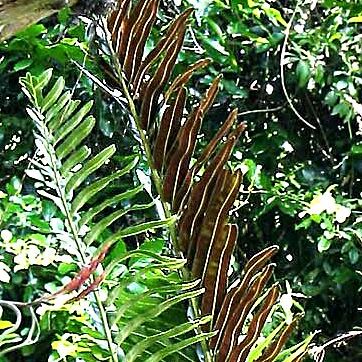Plants terrestrial in fresh-or saltwater habitats. Stems erect or creeping, branched; scales dark brown, concolored, linear-lanceolate, margins entire. Leaves slightly dimorphic, clustered, 1--5 m. Petiole brown, with a single groove adaxially, glabrous, smooth or with scale scars, with several abaxial vascular bundles and 2 adaxial vascular bundles. Blade lanceolate, pinnate, leathery, abaxially glabrous or hispid, adaxially dull, not striate, glabrous; rachis straight. Pinnae stalked, free from rachis, narrowly oblong to lanceolate, 2--5 cm wide; base cuneate; stalk green; margins plane; fertile leaves bearing sporangia on most pinnae or on only more distal pinnae (fertile pinnae may be slightly smaller than sterile ones). Veins of pinnae conspicuous, strongly anastomosing. False indusia absent. Sporangia spread over abaxial surface, mixed with paraphyses (sori acrostichoid), containing 64 spores. Spores yellow, tetrahedral, minutely tuberculate or roughened, equatorial flange absent. x = 30.
Terrestrial ferns of moist ground, often on muddy ± saline substrates. Rhizome stout, creeping to erect, with large scales and thick fleshy prop roots. Fronds to several metres tall. Stipe up to one-third length of frond, scaly at base. Lamina 1-pinnate (simple in juvenile fronds), stiff, coriaceous, glabrous. Pinnae numerous, ascending, narrowly oblong to lanceolate, conspicuously stalked (except perhaps the uppermost ones); upper pinnae smaller and fertile; lower pinnae sterile; lowermost pinnae sometimes reduced; all pinna margins entire. Secondary veins none; tertiary veins forming a close network of oblique (except for the costal ones) elongate-hexagonal meshes without free included veinlets. Sporangia covering lower surface of fertile pinnae, or only in the apical part; paraphyses abundant, filiform, several-celled with dark end-cells. Spores tetrahedral.
Plants terrestrial or in coastal swamps. Rhizome stout, creeping or erect, dictyostelic with additional strands; scales dark brown to black, large, broadly lanceolate, entire. Fronds clustered or approximate; stipe stout, glabrous; lamina 1-pinnate with distinct terminal pinna; pinnae stalked, tongue-shaped to narrowly oblong, thickly papery to thickly leathery or fleshy, entire, apex obtuse to acuminate; veins anastomosing, without included free veinlets. Fertile pinnae distal on frond or most or all of lamina fertile, slightly smaller. Sporangia scattered on whole of abaxial surface; paraphyses capitate, apex lobed and multicellular. Spores tetrahedral-globose, perispore papillate to tuberculate, with rodlets or sparse strands. x = 30.
Stock stout, erect; veins reticulate throughout; only distal pinnae fertile.

